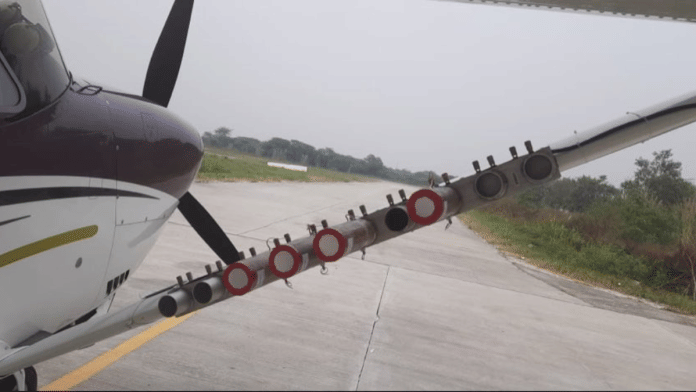New Delhi: Noida and Greater Noida received less than 1 mm of rain on Tuesday, after 8 kg of seeding mixture was sprayed into clouds over northwest Delhi to make artificial rain, according to IIT Kanpur.
A press report by IIT Kanpur, which conducted the trials of cloud seeding, described the process and impact of the trials on rainfall and air quality in the city.
While there was no rainfall in the areas where cloud seeding took place, the report does mention rainfall nearby in Noida. “At 4 p.m., 0.1 mm of rain in Noida and 0.2 mm of rain in Greater Noida were observed, according to data from (weather forecast app) Windy,” read the report.
The report also took information from air quality monitoring stations from the regions where cloud seeding trials were conducted—Burari, Karol Bagh, and Mayur Vihar. It said that PM2.5 levels were between 220 and 230 (poor AQI) before cloud seeding, and went down to 203-207 (poor AQI).
“Given that the winds were negligible, one possible explanation is that the denser moisture content created due to seeding particles has helped in settling down a portion of these particles, which translates to these reductions,” said the report.
This was the second and third time cloud seeding trials were conducted in Delhi to reduce air pollution. It is a new approach by IIT Kanpur and the Delhi environment ministry to induce rainfall and dissipate the suspended particulate matter from the air. However, because of low humidity, moisture content, and general dry weather in Delhi winters, experts have cautioned against using cloud seeding at this juncture.
The first trial took place last week on 23 October, with the same aircraft taking off from IIT Kanpur and injecting clouds over Burari with a silver iodide mixture to prompt rainfall. However, that trial was considered a successful ‘dry run’, because while it tested that all the procedures and materials worked fine, there wasn’t any actual rainfall after the trial.
“There was very low moisture content in the cloud on 23 October, which is why we didn’t see any rain occur,” Delhi Environment Minister Manjinder Singh Sirsa had said.
This time too, the city saw negligible rainfall despite two successive cloud seeding trials in one day. The first flight left from Kanpur to Delhi at around 12:15 p.m. on Tuesday and landed in Meerut, and the second flight left from Meerut at 3:45 p.m., crossed Delhi and then came back to Meerut. In each trial, the flight managed to unload 3-4 kg of the seeding mixture onto the clouds, leading to a total of 8 kg of mixture in one day.
“The moisture content predicted by IMD and other agencies remained low at 10-15 percent, which is not an ideal condition for cloud seeding,” the report said. “However, this situation is also suitable for judging the effectiveness of the seeding material in low-moisture conditions.”
Experts and studies previously have shown that to effectively use cloud seeding, the clouds need to be rain-bearing clouds with at least 50-60 percent moisture content. The weather in Delhi for the next week forecasts no chance of rainfall or rain-bearing clouds, according to the India Meteorological Department (IMD).
In an interview to news channel NDTV, however, IIT Kanpur director Manindra Agrawal said that they will attempt another cloud seeding trial on Wednesday, this time hoping for better results.
(Edited by Tony Rai)
Also Read: Why Delhi’s PM2.5 levels dropped rapidly post Diwali after hitting 4-year high






